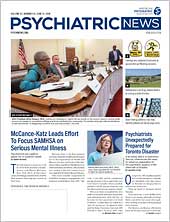Of the tens of thousands of people who die from an opioid overdose in the United States each year, some will have died by suicide.
“Yet most strategies for reducing opioid-overdose deaths do not include screening for suicide risk, nor do they address the need to tailor interventions for suicidal persons,” wrote Maria A. Oquendo, M.D., Ph.D., past president of APA and professor and chair of the Department of Psychiatry at the Perelman School of Medicine at the University of Pennsylvania, and Nora Volkow, M.D., director of the National Institute on Drug Abuse, in a commentary published in the New England Journal of Medicine in April.
“There hasn’t been much attention trained on the idea that many of these people may be doing this intentionally,” Oquendo told Psychiatric News. “What they need is a very different kind of intervention—one that addresses their underlying suicidal ideation.”
In the commentary, titled “Suicide: A Silent Contributor to Opioid-Overdose Deaths,” Oquendo and Volkow noted that opioid-overdose suicides rose from 2.2 percent in 1999 to 4.3 percent in 2014, with the highest increases occurring among people 45 to 64 years of age. (Without a suicide note, the decedent’s intent, as determined by the coroner or medical examiner, is based on the autopsy, information collected at the scene of death, and circumstantial evidence, the authors noted.)
“The distinction between unintentional and volitional deaths may be blurred among people with OUD [opioid use disorder], whose motivation to live might be eroded by addiction,” Oquendo and Volkow wrote. “Such erosion can have a range of effects, from engagement in increasingly risky behaviors despite a lack of conscious suicidal intent to frank suicidal ideation and intent. This entire spectrum can lead to opioid-overdose deaths, but little attention has been given to its contribution to overdose mortality.”
Previous studies have shown that people with OUD are at an increased risk of suicidal ideation and more likely to attempt suicide compared with people who do not seek care for OUD. “Even people deemed to have died of an ‘unintentional overdose’ frequently had suicidal risk factors: depression, substance use disorders, and financial problems,” Oquendo and Volkow wrote.
While the pair commended current efforts to change opioid prescribing practices and expand access to medication-assisted treatments for OUD, they noted that more can be done to educate clinicians about the need to screen for suicide risk in patients with conditions for which opiates are prescribed, especially chronic pain, and in those with a substance use disorder. Additionally, they recommended standardizing screening and treatment referral for suicide risk for patients who present in emergency departments for overdose and improvements in how deaths from drug overdose are classified.
Oquendo added that additional studies are needed “to understand why these people are so vulnerable psychosocially and biologically.” “[R]esearch aimed at the development and validation of screening tools to help characterize suicide risk along a continuum of awareness regarding suicidal intent would improve identification of persons who are at greater risk,” Oquendo and Volkow wrote.
The authors also suggested that education campaigns to increase public awareness and reduce stigma associated with suicide and drug addiction might make people more willing to seek treatment.
“These two epidemics are intermingled, and solutions to address the opioid crisis require that we tailor interventions to preventing opioid overdose deaths due to suicidal intent,” they concluded. ■
“Suicide: A Silent Contributor to Opioid-Overdose Deaths” can be accessed
here. “Suicide Deaths With Opioid Poisoning in the United States: 1999–2014” is available
here.
